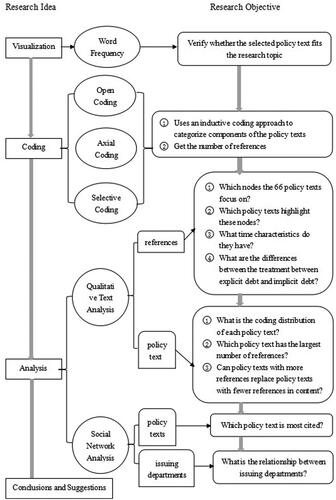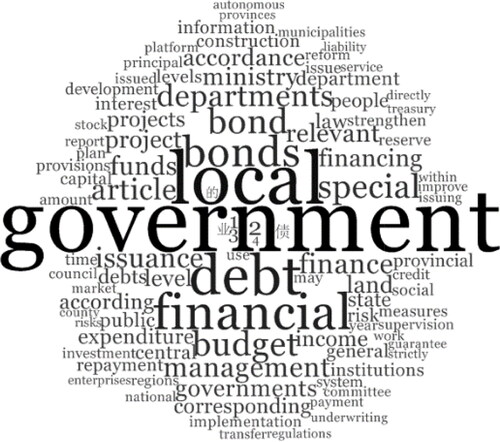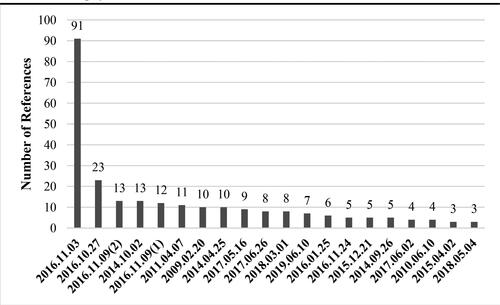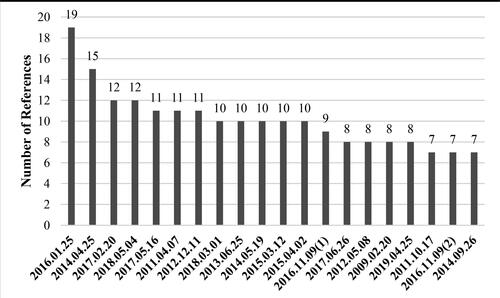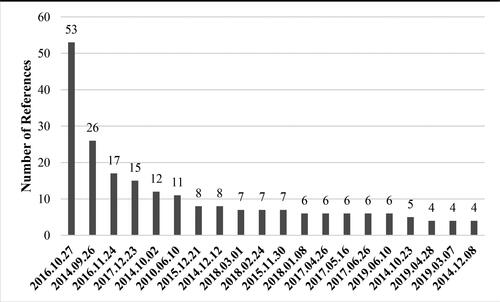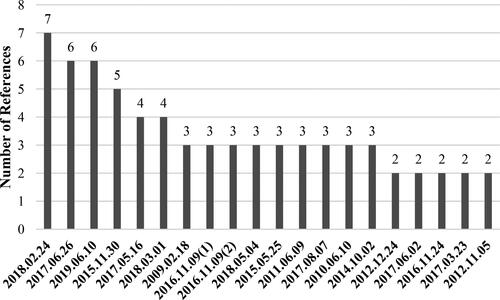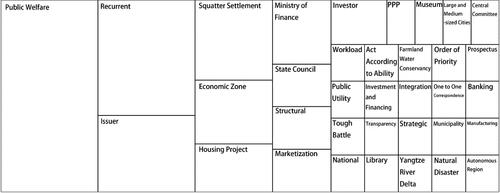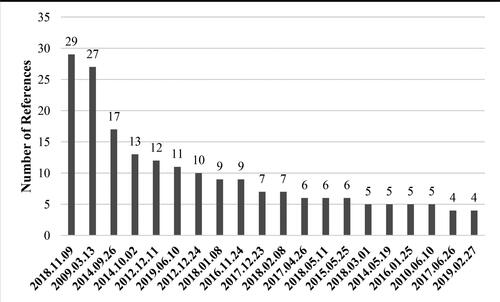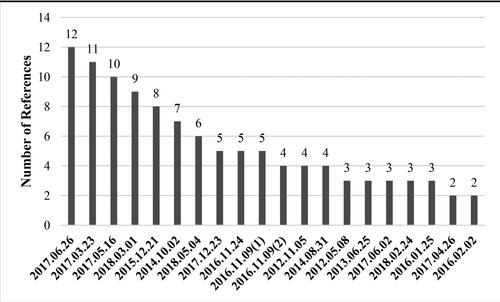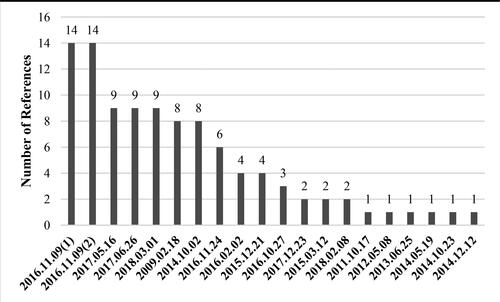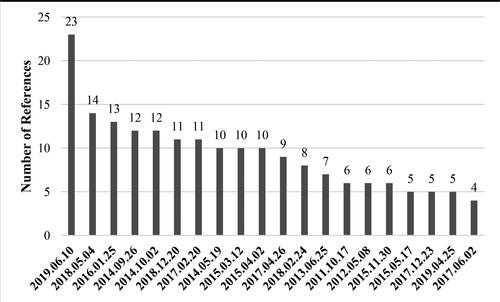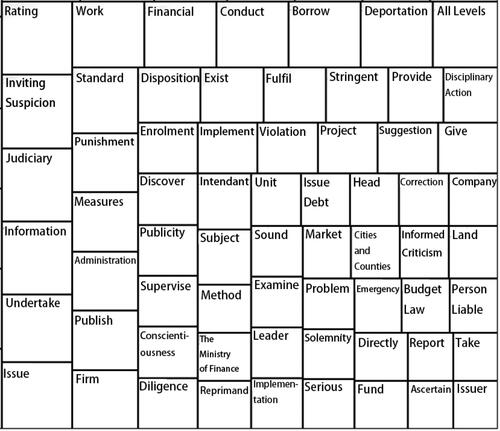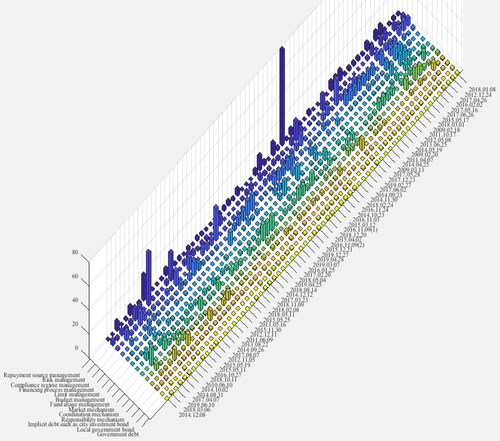 ?Mathematical formulae have been encoded as MathML and are displayed in this HTML version using MathJax in order to improve their display. Uncheck the box to turn MathJax off. This feature requires Javascript. Click on a formula to zoom.
?Mathematical formulae have been encoded as MathML and are displayed in this HTML version using MathJax in order to improve their display. Uncheck the box to turn MathJax off. This feature requires Javascript. Click on a formula to zoom.Abstract
This paper takes 66 local government debt governance policy texts from 2009 to 2019 as sample, and constructs an analysis framework of ‘target debt - management measures - mechanism guarantee’, derives up with identifying the characteristics of determining local government debt governance in China. The results show as follow: (i) It attaches more importance to the policy design of ‘borrowing’, ‘repayment’ and ‘management’ on local government debt instead of the ‘usage’ in China. (ii) The evidence supports the relatively average coding distribution of each policy, but the content is quite different. (iii) It manifests the new development value of ‘people-oriented’ and the concept of collaborative governance in the policy design. (iv) It has formed a ‘centre-edge’ model for the governance of the local government debt. This paper provides a new perspective for the study of the problems of local government debt governance, and puts forward policy recommendations for improving the governance of the local government debt.
1. Introduction
Nowadays the large and growing local government debt in many countries, such as the United States, China, Japan, Spain and Mexico, is alarming policymakers and scholars. Among these countries, China has attracted particular attention. This is because since China has granted local governments the right to issue bonds in 2009, the balance of local government bonds has expanded by 55.85 times in a short decade, i.e., from 400 billion yuan in 2010 to 22341.3 billion yuan in 2020 (WIND database). Theoretically, the moderate borrowing can effectively cover local government's fiscal deficit and promote economic growth (DeLong and Summers, Citation2012; Mao & Huang, Citation2018). However, the blind expansion of local government debt without regime constraints will bring tremendous repayment pressure to local government, and even trigger debt crisis (Borck et al., Citation2015; Navarro-Galera et al., 2020; Yu & Fang, Citation2016). More seriously in China, except for the large-scale explicit debt represented by local government bonds, local governments are providing guarantees to local financing platforms and facilitating the Public-Private-Partnership (PPP). In this process, the scale of implicit debt is expanding, resulting in an increasing risk of local government implicit debt. Under this situation, China has raised the prevention and resolution of local government debt risks to a national level, and issued a series of policies on local government debt governance.
Regarding debt governance policies, it has been widely agreed that ‘it is difficult to manage local government debts well by relying solely on market constraints’, and ‘effective policy design is very necessary to prevent local government debt risks’ (Allers, Citation2015; Berman, Citation2019; Rajbhandari, Citation2021; Zabler, Citation2021). Therefore, many scholars have conducted a comprehensive research on the local government debt governance policies. Generally, the existing research can be divided into two categories: one is to set the policy on local government debt as an independent variable in the econometric model to evaluate the effectiveness of policy intervention in debt reduction; the other is to sort out policies and qualitatively analyze the origin, characteristics, changes and evolution of these policies. (i) For example of the first type of research, Balaguer-Coll et al. (Citation2016) set the dummy variable FORAL and found a negative correlation between the FORALFootnote1 and local government debt scale. Fomina and Vynnychenko (Citation2017) used the Open Budget Index as the proxy indicator for budget transparency, and concluded that the higher the budget transparency, the smaller the scale of local government debt. Chen et al. (Citation2019) set a dummy variable for China’s debt audit time, and found that local governments’ explicit debt risk has reduced significantly since the nation-wide debt audits. (ii) For example of the second type of research, László (Citation2019) explained the policies adopted by EU member states facing high local government debts, and described how countries have designed governance strategies and monitoring mechanisms. An and Ning (Citation2019), by reading China’s policy texts on local government debt governance since 1949, divided the changes of its local government debt regime into four phases. Ishihara (Citation2021) combed Japan's public sector reform and public management theory from 1945 to 2020.
Although the existing research are very enlightening for studying policy effects and combing policies, there are still the following research gaps: (i) The first type of research adopts empirical techniques to examine the policy effect accurately and scientifically. However, the ‘policy’ is only used as a variable to study the relationship between policies and other economic variables rather than taken as a research object to explore the characteristics of policies. (ii) Although the second type of research is beneficial to study the policies and governance model of local government debt in some countries, the majority is focused on conceptual analysis and summary short of empirical study.
Based on the research gaps, how to use empirical techniques to scientifically sort out policies and study the characteristics of policies has become an interesting topic. China, a country with a large scale of local government debt and rich relevant policies, provides a good national sample for us to explore the characteristics of local government debt governance. From the perspective of the policy texts, what are the characteristics of China’s local government debt governance? What is the focus of the policy texts? What is the value tendency of local government debt governance in China? Which policy text is at the core leading position? What is the relationship between the issuing departments? Can policy design be improved? To answer the questions above, it is necessary to jump out of the appearance, to reveal the evolution, orientation and goals of China’s local government debt governance. Only by scientifically exploring these policies can we put forward suggestions for China to improve the policy design of managing local government debt, and provide reference for other countries facing the similar problem.
Since the method of qualitative text analysis from bibliometrics has been proved to be a feasible tool for theoretical research and can provide empirical evidence, this paper applies qualitative text analysis to the actual case of local government debt governance in China, and reviews, interprets the policy texts in terms of the characteristics.
The marginal contributions of this paper are as follows: (i) The qualitative text analysis is introduced into the field of local government debt, which proposes a new feasible method for identifying and analyzing the characteristics of local government debt governance. (ii) It has enriched the research on the topic of China's local government debt governance regime and policies by providing some data proofs such as coding, which has increased the objectivity and credibility of the research.
The rest of the paper is organized as follows. In section 2, we propose a new grounded theory in qualitative text analysis methods, and adopt the steps of ‘open coding-axial coding-selective coding’ to create nodes, divide different categories, and counts references. Section 3 is the qualitative texts analysis in terms of references and policy texts. Social network analysis of policy texts and issuing departments are considered in section 4, and followed by a conclusion with a discussion in section 5.
2. Methodology, sources and research design
2.1. Methodology
Among many methods of qualitative text analysis, grounded theory has turned the potential advantage into generalization, reproducibility and accuracy, by adopting rigorous and scientific research procedures. Therefore, this paper adopts grounded theory, to study the characteristics of China’s local government debt governance.
Considering that NVivo software developed by QSR company in Australia is a qualitative research software, which can effectively analyze a variety of different words, images and graphics, etc., this paper uses NVivo software as a qualitative text analysis tool.
2.2. Sources
Considering the maneuverability of qualitative text analysis and the year 2009 as an epoch-making year of China’s local government debt issuance, this paper uses the website query method to collect the policy texts on local government debt governance from 2009 to 2019, and takes these policy texts as a research sample. The sample is collected on the basis of the following principles:
Relevance: Policy texts unrelated to local government debt governance will not be selected.
Authority: The central government portal (www.gov.cn) is taken as the preferred website for sample collection. If the central government portal is not available, the Google or Baidu Encyclopedia is taken as an alternative website.
Integrity: All policy texts downloaded are detailed, including the title, issuing department, content details and issuing time.
Normalization: The content of the policy text conforms to China's official administrative document specifications.
Consequently, this paper collects 66 policy texts issued by the State Council, Ministry of Finance, National Development and Reform Commission, etc. In order to facilitate text management, this paper names these policy texts in the form of ‘issuing time + issuing department + title’Footnote2. The policy types and the corresponding numbers in units of years are shown in .
Table 1. Basic characteristics of policy text.
From , the following conclusions can be drawn: since the year 2014, the number of policy texts on local government debt governance has increased significantly in China, and the peaks appeared in 2017 and 2018. It is a concrete manifestation that China's policy regime actively adapts to the rising risks of local government debt. Moreover, in terms of policy type, the policy texts are mainly issued in the form of notices, measures and opinions; while overall laws are lacking. So far, the only law is the ‘Budget Law of the People's Republic of China (revised in 2014)’, indicating that the construction of local government debt governance laws and regulations needs to be constructed urgently.
2.3. Research design
The research ideas and objectives of this paper are shown in :
2.3.1. Visualization
The function of ‘word frequency’ in NVivo.11 is used to get the word cloud of , in which the larger the word size, the higher frequency of the word in the texts. It can be seen from that the words ‘government, local, debt, financial, bond, budget, management’ appear more frequently in the 66 policy texts, which is consistent with the topic of this paper. However, the word cloud cannot show the details and distribution characteristics of these policy texts. Therefore, it is necessary to code the 66 policy texts step by step, in order to decompose and conceptualize the text data.
2.3.2. Coding
The first step lies in early concept identification (Corbin & Holt, Citation2004), which is called open coding or initial coding. To facilitate the early concept identification, a number of questions are designed to assist with open coding. What is discussed here? How to define it? How does this process develop? By reading these policy texts word by word, a total of 2013 nodes have been found such as ‘improve the local government debt supervision and accountability mechanism’. Due to the large number of nodes, a series of keywords is designed to help us to explore early concepts. Much work has been done to obtain 45 early concepts with classification and combination of keywords with similar meanings. Full details are given in . It should be noted that: (i) Our coding team consists of two people, i.e., User Group A and User Group B. They coded independently and well prepared for the coding comparison below. (ii) The principle of ‘relevance’ mentioned above has been strictly implemented. In the policy texts with the topic of ‘budget law’, ‘public private partnership’ and ‘banking risk prevention and control’, the content of local government debt is focused on to keep the research refined. (iii) When some nodes involve one or more early concepts, the semantics is used to determine its category. For example, some nodes with ‘underwriting’ say that ‘targeted underwriting is adopted for bond issuance’, which emphasize the market-oriented way of bond issuance. Then, these nodes are assigned to the ‘market-oriented underwriting’. While some nodes with ‘underwriting’ describe certain formalities such as ‘signing and filing must be performed in the process of underwriting issuance’. Such nodes refer to the ‘issuance arrangement’. Some nodes with ‘underwriting’ explain ‘what can't be done in the underwriting’, which are classified in the ‘regime requirement’.
Table 2. The formation of tree node, reference and source.
The second step is axial coding. As more and more early concepts are recognized, the number of nodes is increasing. In order to extract logical conclusions, it is necessary to construct a tree node composed of parent nodes and child nodes. Then, relationship between the early concepts is analyzed to sum up them into 13 child nodes, such as ‘government debt, repayment source management, responsibility mechanism’, etc., shown in .
The third step is selective coding. In this step, core categories are selected from all the discovered conceptual categories by systematic analysis, and the analysis is continuously focused on the nodes related to the core categories. According to the core meaning of the 13 child nodes, three highly generalized parent nodes have been extracted, which are the ‘target debt’, ‘management measure’ and ‘mechanism guarantee’, shown in .
2.3.3. Consistency test
The coding completed by User Group A and User Group B are compared to measure the consistency between the two users, thus the reliability of the research can be examined. In this process, User Group B randomly selects one policy text per year from the 66 policy texts and recodes the 11 policy texts. The percentage agreement detailed in EquationEq. (1)(1)
(1) can be obtained by the Import Project function of NVivo.11:
(1)
(1)
where
is Percentage Agreement,
and
can be defined as a total number of nodes and number of nodes coded by only one of the two users, respectively.
As shown in , the percentage agreement of the sampled policy texts are all above 90%, reflecting the high reliability of this paper.
Table 3. Percentage agreement.Table Footnotea
3. Qualitative text analysis
Theoretically, the more references a node has, the more information is gathered on the node, and the more attention has been paid to the node (He et al., Citation2018; Liu & Li, Citation2017). By using the Query function of NVivo.11, the references and sources for parent nodes and child nodes can be obtained, as shown in .
From , the parent node ‘target debt’ captures 97 references, accounting for 4.82%; whereas the parent node ‘management measure’ shares 1429 references, making up more than 70.99% of the total; and the parent node ‘mechanism guarantee’ absorbs 487 references, compared to 24.19%. The number of references reflect that the policy texts are designed with much emphasis on specific ‘management measures’ for local government debt.
3.1. Target debt- in terms of references
‘Target debt’ is one of the parent nodes in . In the ‘target debt’, there is a similarity in the number of references and sources between the child nodes ‘local government bond’ and ‘implicit debt such as city investment bond’, which reflects that implicit debt and explicit debt are treated equally in China. Another 24 references from 24 policy texts refer to the child node ‘government debt’, which reveals that China has a comprehensive concept of local government debt governance, without any prejudice to explicit debt or implicit debt. Then, the child nodes of ‘management measure’ and ‘mechanism guarantee’ will be focused on to observe:
Which policy texts highlight these child nodes?
What temporal characteristics do these child nodes have? A time limit or peak?
If there is no obvious time limit or peak, a tree map will be conducted to further analyze its content.
3.2. Management measure- in terms of references
From , the number of references for the child nodes of ‘management measure’ shows that China particularly emphasizes the ‘repayment source management’, ‘financing process management’ and ‘risk management’. Although the ‘fund usage management’ have been mentioned by 39 policy texts, its references are relatively small in number, which reflects that the policy design of ‘borrowing’, ‘repayment’ and ‘management’ of local government debt are paid more attention than the ‘usage’.
For the 10 child nodes of ‘management measure’ and ‘mechanism guarantee’, what temporal characteristics do they have? To answer the question, is formed. Then, the standard deviation of the number of references is calculated for each child node. It is found that 17.01 is the mean value of these standard deviations. Thereupon, a stable temporal distribution is defined- if the number of references of the child node in does not fluctuate a lot with a standard deviation lower than 17, and the issuing time of the policy texts ranking the top 20 does not concentrate in a certain year, then the child node will be considered to be stably distributed.
Figure 3. The temporal characteristics of child nodes of ‘management measure’ and ‘market mechanism’ based on the number of references.
Source: drawn by the authors based on NVivo.11 software.
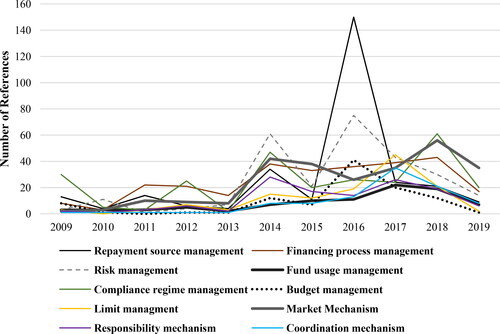
3.2.1. Repayment source management
It can be seen from that the references disclosing the ‘repayment source management’ show a peakFootnote3 of the year 2016. The peak can be confirmed again in , in which the three policy texts with the most disclosure on ‘repayment source management’ are all issued in 2016. By tracing the nodes of the three policy texts, it is found that the repayment responsibilities of different types of local government debt are described, the scope of revenue and expenditure and the treatment methods of principal and interest repayment are detailed in their content.
3.2.2. Financing process management
It can be seen from that references disclosing the ‘financing process management’ do not concentrate in a certain year as those of the ‘repayment source management’. Specifically, the standard deviation of references of this child node is only 13.63, lower than the mean value of 17. Further, it can be seen from that the top 20 policy texts basically span the entire sample interval, and the top 3 policy texts are distributed in 3 different years, without showing a very obvious time limit. Then, a tree map is conducted to study the content of ‘financing process management’ and the results are shown in . Excluding those words without semantic meanings, high frequency words can be extracted such as ‘underwriting, register, pricing’, etc., which fully demonstrate the ‘process control’ model of local government debt governance in China.
Figure 6. Tree Map of ‘Financing process management’Footnote12.
Source: drawn by the authors based on NVivo.11 software.
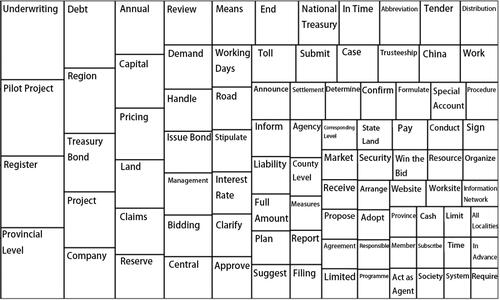
3.2.3. Risk management
The results of and for the ‘risk management’ are presented as follows: (i) From , the policy texts issued in 2016 disclose more about ‘risk management’. In addition, the standard deviation of the number of references is calculated to be 25.10, above the mean value. (ii) It can be seen from that most of the top 20 policy texts are promulgated since 2014. Since then, China has paid more attention to prevent the local government debt risk. (iii) The most disclosed policy text for ‘risk management’ is the ‘Emergency-handling Preplan for Local Government Debt Risks’, which lists the controlling work of China’s local government debt risks from two aspects. One is to set up an emergency-handling mechanism, the other is devoted to strengthen the assessment and early warning of risk events, which fully shows a more comprehensive design of risk control for China’s local government debt.
3.2.4. Fund usage management
From , the fewest references in the ‘management measure’ is the ‘fund usage management’. It can be seen from that the references of ‘fund usage management’ are not like either those of ‘repayment source management’ having a policy peak, or those of ‘risk management’ having an obvious time limit. In fact, its standard deviation is only 6.71, which is the minimum value among the 10 child nodes. Moreover, it can be seen from that the policy texts from 2009 to 2012 appear many times in the top 20 policy texts, without showing obvious temporal characteristics.
Then, a tree map is constructed and the results are as follows: (i) Excluding some non-semantic words, some high frequency words are presented in , such as ‘public welfare, squatter settlement’, etc. After tracing the corresponding nodes, it is found that the flow of local government debt funds in China has a tendency to education, medical care, pensions and other public welfare undertakings rather than inefficient project, repetitive construction, high energy consumption and pollution field, which fully demonstrates the new development value of ‘people-oriented’. (ii) After analyzing the contents of the nodes, it is known that some policy texts clearly stipulate the usage of local government debt funds, such as ‘toll road special bond funds should be used exclusively for government toll road project construction’, making the usage of local government debt funds more standardized and stricter. (iii) The nodes about the ‘fund usage management’ only focus on the issue of ‘where to use’ rather than ‘how to use’, which fail to address the way to improve the efficiency of local government debt allocation and maintain the solvency of local governments. (iv) There is no escaping the fact that the projects of public welfare undertakings always have a long payback period. Therefore, the key point to prevent and defuse local government debt risks will lie in maintaining public welfare as well as improving the quality and efficiency of local government debt funds.
3.2.5. Compliance regime management
The ‘compliance regime management’ in deserves attention due to its largest number of sources and a large number of references. In , the number of its references fluctuates a lot with a larger standard deviation of 18.05, which is above the mean value. In addition, two subtle peak of the year 2014 and 2018 are shown in , especially the year 2018, which can be confirmed again by the top 1 policy text in . That is, the ‘Government Accounting Standards No.8-Liabilities’ issued on November 9, 2018, aiming to establish a regulation system of government accounting in China.
3.2.6. Limit management and budget management
Although the references and sources of the ‘limit management’ or ‘budget management’ do not account for much in the ‘management measures’, there are still some temporal characteristics for them. It can be seen from that the policy texts issued in 2017 disclosing the most on the ‘limit management’, and the top 3 policy texts in are all from 2017, showing an obvious peak. Coincidentally, the ‘budget management’ shows an obvious peak in 2016, which can be confirmed again by the top 20 policy texts in .
3.3. Mechanism guarantee- in terms of references
3.3.1. Market mechanism
It can be seen from that the ‘market mechanism’ is the most important component of the ‘mechanism guarantee’. And in , more and more references have disclosed about the ‘market mechanism’Footnote4 since the year 2014, reflecting a time limit. Further, it is known from in that the 20 top policy texts span the entire sample interval, and the top 1 policy document is from 2019.
By tracing the corresponding nodes, it is found that the market-oriented measures are aimed at stimulating the vitality and development potential of market participants. Although marketization is advocated in China, there are still many problems in current practice. For example, in terms of credit rating, China's current credit rating mode places emphasis on ‘entrusted rating’ and ‘issuer pays’, which leaves room for rent-seekingFootnote5. In addition, there are few qualified and widely recognized credit rating agencies in the market, which further affects the objectivity and impartiality of the credit rating (Hong, Citation2019; Chan & Yang, Citation2020). In terms of promoting the market-oriented transformation of financing platforms, it is common to make transformation announcements by some platforms, without solving problems about the internal modern corporate system, rather than a scientific corporate development strategic plan. Therefore, it has a long way to realize what’s the real transformation for the financing platforms in China (Gu et al., Citation2017).
3.3.2. Responsibility mechanism
The ‘market mechanism’ is not the whole story. Without the support of ‘responsibility mechanism’ and ‘coordination mechanism’, China's local government debt governance will return to the old path filled with traditional growth logic. Therefore, there are 124 references from 42 policy texts make contribution to the ‘responsibility mechanism’, while 98 references from 37 policy texts lie in emphasizing the ‘coordination mechanism’, as detailed in .
It can be seen from that the references of the ‘responsibility mechanism’ are stable during the sample period, with a standard deviation of 9.99, which is much lower than the mean value. In addition, policy texts from 2012 and before have appeared many times in the top 20 policy texts of this child nodeFootnote6.
Then, a tree map is conducted and the results are shown in . Excluding some non-semantic words, some high frequency words can be extracted such as ‘judiciary, punishment, diligence, disciplinary action’. By tracing the corresponding nodes, it is found that punishment accountability and policies of ‘lifelong accountability, reverse investigation responsibility, implementation of inter-departmental joint disciplinary action’ have been frequently mentioned in recent years. In addition, not only local officials have to take responsibilities, but also financial institutions and intermediaries.
3.3.3. Coordination mechanism
It is known from that the peak of the ‘coordination mechanism’ appeared in 2017, which can be confirmed again by the top 20 policy texts in Footnote7. By tracing the nodes of the ‘coordination mechanism’, it is found that the corresponding departments include several departments, such as the State Council and Ministry of Finance, etc., and China tries to mobilize multi-department and multi-industry participation in local government debt governance in order to improve the matching, consistency and effectiveness in cooperation.
3.4. In terms of policy texts
The following of this paper analyzes the coding distribution of each policy text. The results are shown in , where the X axis is the 13 child nodes in turn, Y axis is the name of the policy texts, and Z axis is the number of the corresponding references.
From , it is known that the ‘repayment source management’ in the ‘Guidelines for Classified Disposal of Local Government Debt Risk’, the ‘risk management’ in the ‘Emergency-handling Preplan for Local Government Debt Risks’ and ‘Opinions on Comprehensively Strengthening the Risk Prevention of Corporate Bonds’, the ‘compliance regime management’ in the ‘Government Accounting Standards No.8-Liabilities’ and ‘Measures for the General Budget Accounting for Local Government Bonds Issued by the Ministry of Finance’ have obviously more references, but the coding distribution of other policy texts is relatively balanced, which reflects that China has taken a very comprehensive consideration in the policy design.
Unfortunately, the details of the largest number of references and maximum amount of information cannot be shown in , thus a tree map is conducted, shown in . It can be seen from that the largest area is occupied by two columns on the left, leading to the corresponding policy texts with more references and more informationFootnote8. Can policy texts with more references replace the policy texts with fewer references? With the ‘cluster analysis’ function of NVivo.11 and the Pearson coefficient detailed in EquationEq. (2)(2)
(2) , the word similarity of policy texts can be obtained:
(2)
(2)
where
is the Pearson coefficient. Then, the policy texts with the Pearson coefficient greater than 0.7 are clustered and form .
Figure 17. Source comparison by the number of references.
Source: drawn by the authors based on NVivo.11 software.
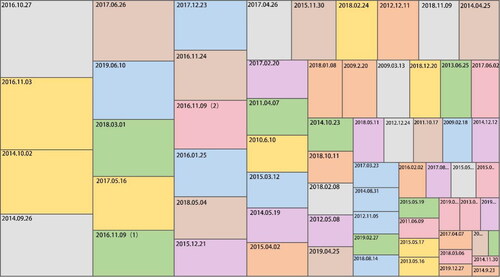
Figure 18. Cluster analysis according to word similarity.
Source: drawn by the authors based on NVivo.11 software.
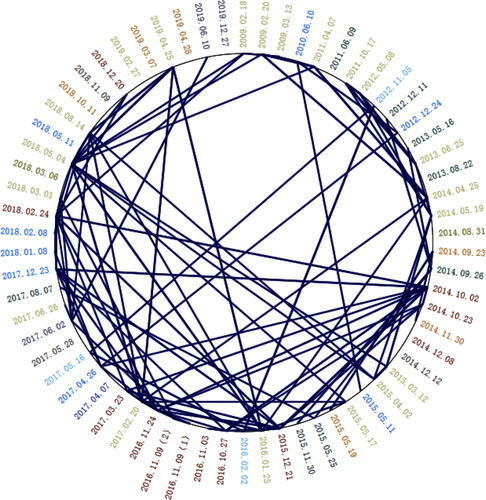
It can be seen from that there are some similarities in content of some policy texts. For example, the five policy texts with more references in are shown to be similar in content to 6, 1, 8, 4 and 1 policy texts, respectively. While the ‘Notice of the Ministry of Finance on the Effective Management of 2018 Local Government Debt’Footnote9 and the ‘Notice of the Ministry of Finance on Pilot Development of Local Government Special Bonds with Balanced Project Income and Self-financing’Footnote10 with relatively fewer references are similar to 9 and 6 policy texts, respectively. The above facts reflect that not a certain policy text with more references will necessarily have more policy texts sharing content with it. In other words, even the policy text with the largest number of references cannot cover all policy texts in content, showing quite different contents of the 66 policy texts.
4. Social network analysis
4.1. Social network analysis of policy texts
The previous studies have found that some policy texts are related to each other in terms of content similarity. According to Deng (Citation2019), the content correlation between policy texts largely stems from the mutual citation between texts. This paper cannot help thinking: which policy text drives the delivering of other policy text?
With the help of the ‘graph’ function in NVivo.11, the most highly cited policy texts can be obtained. The result is shown in , with the area of the dot representing the betweenness centrality detailed in EquationEq. (3)(3)
(3) :
(3)
(3)
Where
is betweenness centrality.
Figure 19. Social network analysis of policy texts.
Source: drawn by the authors based on NVivo.11 software.

From , the betweenness centrality of the ‘Opinions of the State Council on Strengthening the Management of Local Government Debt’ and ‘Budget Law of the People's Republic of China (revised in 2014)’ are significantly higher than those of other policy texts. In fact, the betweenness centrality of the two policy texts are calculated to be 666.23 and 527.23, respectively. Such high betweenness centrality is in line with the following discoveries in some previous papers: a study found by Zhao (Citation2015) is that ‘the promulgation of the ‘Opinions of the State Council on Strengthening the Management of Local Government Debt’ has a significant impact on breaking the original local debt ecosystem and making the transformation of local government’. Preliminary work was undertaken by Gu et al. (Citation2017) who claimed that ‘the new budget law can be called China's economic constitution, which will lay the foundation for the legalization of local government debt’.
4.2. Social network analysis of issuing departments
The 66 policy texts involved 14 issuing departments of China, i.e., the Ministry of Finance, National Development and Reform Commission, etc. From the perspective of policy texts, there are 14 policy texts jointly issued by different departments, and the jointly issued policy texts have increased since 2017, reflecting that China has focused on the inter-departmental ties and collaborations in local government debt governanceFootnote11. Among the jointly issued policy texts, the Ministry of Finance participated in 13 texts, People's Bank of China made up 7 texts, China Banking Regulatory Commission accounted for 6 texts, National Development and Reform Commission hit the percentage of 5 texts, State Council and Ministry of Land and Resources each absorbed a share of 3 texts, and the rest of departments have been shrink to only 1 text or issued independently, reflecting that the Ministry of Finance plays a major role in contact with other departments.
In order to dig out the relationship between the issuing departments, a social network analysis is conducted with the area of dot representing the centrality degree of the issuing department. It can be seen from that the Ministry of Finance, State Council, People's Bank of China, China Banking Regulatory Commission and National Development and Reform Commission are important central points. Among them, the Ministry of Finance is most closely connected with other issuing departments, followed by the State Council, People’s Bank of China, China Banking Regulatory Commission and National Development and Reform Commission. Whereas, other issuing departments are at the edge of the social network. To sum up, China has formed a ‘centre-edge’ model for the governance of local government debt, where the Ministry of Finance is responsible for the core, the State Council, People's Bank of China, China Banking Regulatory Commission and National Development and Reform Commission play the role of central points, and other departments respond to the core and central points.
Figure 20. Social network analysis of issuing departments.
Source: drawn by the authors based on NVivo.11 software.
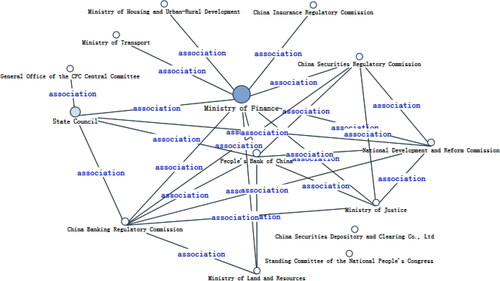
From another perspective, China’s local government debt governance requires inter-departmental collaboration with some warnings: (i) The coordination faces some challenges. So far, China has not issued any relevant policies on how to restrict these departments, how to define the cross functions among them, how to prevent inter-departmental responsibility shifting. In other words, this inter-departmental collaborative governance has still to be found and discovered. (ii) The cooperation with the marginalized departments in needs to be deepened in the future.
5. Conclusion
The goal of this paper is to study the characteristics of governance of China’s local government debt from the perspective of policy texts issued. Different from the existing research, this paper does not take the ‘policy’ as a variable to empirically test the relationship between policies and other economic variables, nor subjectively analyze policies by combing the policy texts. Instead, this paper introduces the qualitative analysis and social network analysis into studying the policy texts, and uses an inductive coding approach to categorize components of these policy texts. Phrases are first inductively assigned to categories in the NVivo software, which are then grouped into larger categories in two rounds (child nodes and parent nodes). Finally, the characteristics of local government debt governance in China are identified:
(i) China has formed an institutional framework with the main body of notices, measures and opinions and a ‘centre-edge’ governance model with the Ministry of Finance as the core, the State Council, People's Bank of China, China Banking Regulatory Commission and National Development and Reform Commission as the central points, and other departments as the response points. (ii)The implicit and explicit debt are treated equally based on the references and sources. (iii) In the ‘management measures’, China more concerns the policy design of ‘borrowing’, ‘repayment’ and ‘management’. Additionally, the policy texts about ‘repayment’ and ‘management’ show peak and time limit. (iv) In the ‘management measure’, the ‘fund usage management’ has the fewest references without obvious temporal characteristics. However, the flow control of local government debt funds highlights China's new development value of ‘people-oriented’. (v)The ‘compliance regime management’ has a peak. The relevant policy texts aim to establish a regime of government accounting standards and a unified regulation of local government debts. (vi) Both the ‘limit management’ and ‘budget management’ have subtle peak. (vii) In the ‘mechanism guarantee’, the ‘market mechanism’ has been emphasized mostly, followed by the ‘responsibility mechanism’ and ‘coordination mechanism’. Both the ‘market mechanism’ and the ‘coordination mechanism’ show a peak, while the ‘coordination mechanism’ does not. (viii) The evidence supports the relatively average coding distribution of each policy, but the content is quite different. (ix) The ‘Opinions of the State Council on Strengthening the Management of Local Government Debt’ and ‘Budget Law of the People's Republic of China (revised in 2014)’ play the programmatic role on subsequent policy texts.
Based on the above conclusions, there are some policy recommendations to be put forward for China: (i) There is an urgent to promote government debt legislation and enact local public debt laws as soon as possible. (ii) It is suggested to establish a market to retransfer local government bonds and develop a social monitoring mechanism for the usage of local government debt funds. (iii) Local governments should take the responsibility to carry out market-oriented ‘mixed reforms’ on financing platforms. (iv) It is necessary to set up a problem-oriented policy-making mechanism, and carry out in-depth analysis and multi-party demonstrations on how to improve the effectiveness of coordinated governance.
This paper also sheds new light on local government debt risks to other countries facing similar problems. Other countries or regions can learn from this paper to study their own debt management policies, identify the characteristics of their own debt governance, and find policy improvements. In addition, other countries or regions can draw useful experience from China's local government debt governance model. However, there still exists a limitation of this paper. That is, the research materials are limited to policy texts due to too few relevant audio and video materials.
Future research is expected to focus on the following points: (i) When China issues a large number of relevant audio and video materials, we will conduct in-depth research on these non-text materials. (ii) Since China has a series of lively practices and innovations in the local government debt governance with a unique political, cultural and institutional environment, we will not only study the research materials, but also extract management theories from these materials and put forward more interesting research topics.
Disclosure statement
The author declares no conflict of interest.
Additional information
Funding
Notes
1 Since Spanish local governments in foral regions are more independent in managing transferred taxes than local governments in non-foral regions.
2 Details are in Appendix.
3 The standard deviation of this child node is 42.03, far above the mean value.
4 The standard deviation of number of references for "market mechanism" is 18.42, above the mean value.
5 In practice, almost all provincial government bonds in China are rated as the highest AAA grade, with obvious inflated rating (An & Ning, Citation2019; Lam & Wang, Citation2018).
6 Due to the limited space of the paper, there is no figure here, interested readers can ask the author for a copy.
7 Policy texts issued in 2017 appear the most in the top 20 policy texts.
8 The top five policy texts are the "Emergency-handling Preplan for Local Government Debt Risks", "Guidelines for Classified Disposal of Local Government Debt Risks", "Opinions of the State Council on Strengthening the Management of Local Government Debt", "Opinions on Comprehensively Strengthening the Risk Prevention of Corporate Bonds" and "Measures for the Management of Local Government Toll Road Special Bond (Trial)", with the number of references of 416, 392, 348, 336 and 288 respectively.
9 The number of references of this policy text is 144.
10 The number of references of this policy text is 96.
11 In fact, more than half of the jointly issued policy texts are issued since 2017.
12 The larger the area of the rectangle, the higher frequency of the word. In addition, all policy texts imported in NVivo are in Chinese, and the selected word length of Chinese characters is 2. After we got the Chinese version of the tree map, we translated it into English, the same below.
References
- Allers, M. A. (2015). The Dutch local government bailout puzzle. Public Administration, 93(2), 451–470. https://doi.org/10.1111/padm.12123
- An, B. J., & Ning, X. (2019). Seventy years of reform of China's local government debt management system: Institutional change, practical dilemma and path choice. Academic Exploration, 8, 28–34.
- Balaguer-Coll, M. T., Diego, P., & Emili, T. A. (2016). On the determinants of local government debt: Does one size fit all? International Public Management Journal, 19(4), 513–542. https://doi.org/10.1080/10967494.2015.1104403
- Berman, D. R. (2019). Localities in state politics (2nd ed.). Local Government and the States: Autonomy, Politics, and Policy.
- Borck, R., Fossen, F. M., Freier, R., & Martin, T. (2015). Race to the debt trap? - Spatial econometric evidence on debt in German Municipalities. Regional Science and Urban Economics, 53, 20–37. https://doi.org/10.1016/j.regsciurbeco.2015.04.003
- Bringer, J. D., Johnston, L. H., & Brackenridge, C. H. (2004). Maximizing transparency in a doctoral thesis: The complexities of writing about the use of QSR*NVivo within a grounded theory study. Qualitative Research, 4(2), 247–265. https://doi.org/10.1177/1468794104044434
- Chan, J. L., & Yang, Q. S. (2020). New development: China seeks better capital investment and credit assessment. Public Money & Management, 40(1), 81–84. https://doi.org/10.1080/09540962.2019.1651037
- Charmaz, K. (2006). Constructing grounded theory: A practical guide through qualitative analysis. Sage.
- Chen, W. C., Yang, Y., Bai, J. M., & Yu, Y. M. (2019). Impact of debt audit on local governments’ debt risk- empirical test based on 2008 ∼ 2016 provincial panel data in China. Auditing Research, 4, 29–38 + 47.
- Corbin, J., & Holt, N. L. (2004). Grounded theory. In B. Somekh & C. Lewin (Eds.), Research methods in the social science (vol. 3, pp. 49–55). London: Sage.
- DeLong, J. B., & Summers, L. H. (2012). Fiscal policy in a depressed economy. Brookings Papers on Economic Activity, 2012(1), 233–297. https://doi.org/10.1353/eca.2012.0000
- Deng, K. (2019). Text analysis of public policy on internet governance in china-qualitative research based on the of NVivo. Journal of Fujian Administration Institution, 4, 50–61.
- Fomina, J., & Vynnychenko, N. V. (2017). Fiscal transparency: Cross-country comparisons. Business Ethics and Leadership, 1(2), 39–46., https://doi.org/10.21272/bel.1(2).39-46.2017
- Glaser, B. G. (1978). Theoretical sensitivity: Advances in the methodology of grounded theory. Sociology Press.
- Glaser, B. G., & Strauss, A. (1967). The discovery of grounded theory: strategies for qualitative research. Aldine.
- Gu, S. Z., Han, L. Y., & Wu, Y. B. (2017). Problems in local government debt and the governance routes. Jianghai Academic Journal, 6, 82–88.
- Guo, Y. Q., & Mao, J. (2019). Local government debt governance in China in the past 70 years: Review and prospect. Finance & Trade Economics, 9, 51–64.
- He, W. S., Du, X. L., & Ren, P. L. (2018). Evolution characteristics of China’s Policy of rural poverty alleviation in new century and its value orientation: on the basis of the analysis of the policy texts of Gansu Province. Journal of Beijing Administrative College, 6, 42–50.
- Hong, X. D. (2019). Finance" "Politics" and "Law": The three-dimensional structure of local debt governance—Based on the history of local debt in the seventy years since the founding of PRC. Contemporary Economic Management, 9, 75–82.
- Ishihara, T. (2021). Public sector reform and public management theory- cases of Japan. Public Management Review, 1–10. https://doi.org/10.1080/14719037.2021.1893093
- Lam, W. R., & Wang, J. S. (2018). China's local government bond market. IMF Working Papers, WP/18/219.
- László, V. (2019). Local government debts in the EU Countries [Paper presentation]. In the 27th NISPAcee Annual Conference, Prague, Czech Republic WG5.
- Liu, S. M., & Li, Z. W. (2017). NVivo10 iconography and application. Economic Daily Press.
- Mao, J., & Huang, Y. C. (2018). Local debts, regional disparity and economic growth: An empirical study based on China's prefecture—Level data. Journal of Financial Research, 5, 1–19.
- Mao, J., & Xu, J. W. (2019). Reality base of research on China’s local government debt-institutional transition, statistical methods and key facts. Public Finance Research, 1, 3–23.
- Navarro-Galera, A., Juan, L. R., Dionisio, B. C., & Salvador, R. C. (2020). Analyzing political and systemic determinants of financial risk in local governments. Transylvanian Review of Administrative Sciences, S.I., 104–123. https://doi.org/10.24193/tras.59E.6
- Rajbhandari, A. R. (2021). China’s local government debt and fiscal policy: Towards consistency. Nice Special Report, #1009.
- Shi, Z. F., Dai, Q. Q., Zhong, C. M., Zhang, X. Y., , Zhao, C., & Shang, H. C. (2020). The qualitative research of the prevention and treatment of traditional chinese medicines on corona virus disease 2019 using software Nvivo. Journal of Jinan University (Natural Science & Medicine Edition), 2, 163–174.
- Strauss, A., & Cobin, J. (1998). Basics of qualitative research: Techniques and procedures for developing grounded theory. Sage.
- Ye, X., & Li, X. (2018). Talking about the management policy of local government debts from the State Council No.43 document [EB/OL]. https://www.sohu.com/a/245649043_726670.
- Yu, Q., & Fang, W. (2016). Research on China's local government debt problem and governance. Review of Economic Research, 14, 10–21.
- Zabler, S. (2021). Uncovering the effect of local government debt brakes in Germany using synthetic controls. Local Government Studies, S2021, 1–23. https://doi.org/10.1080/03003930.2021.1986392
- Zhang, Q. J., & Min, X. Y. (2020). Institutional changes, scale structure and debt risk reduction of local government. Jianghan Tribune, 1, 24–30.
- Zhao, X. (2015, June 4). The "Balancing Technique" of local debt governance is only a temporary measure. Economic Information Daily. http://dz.jjckb.cn/www/pages/webpage2009/html/2015-06/04/content_6364.htm.

